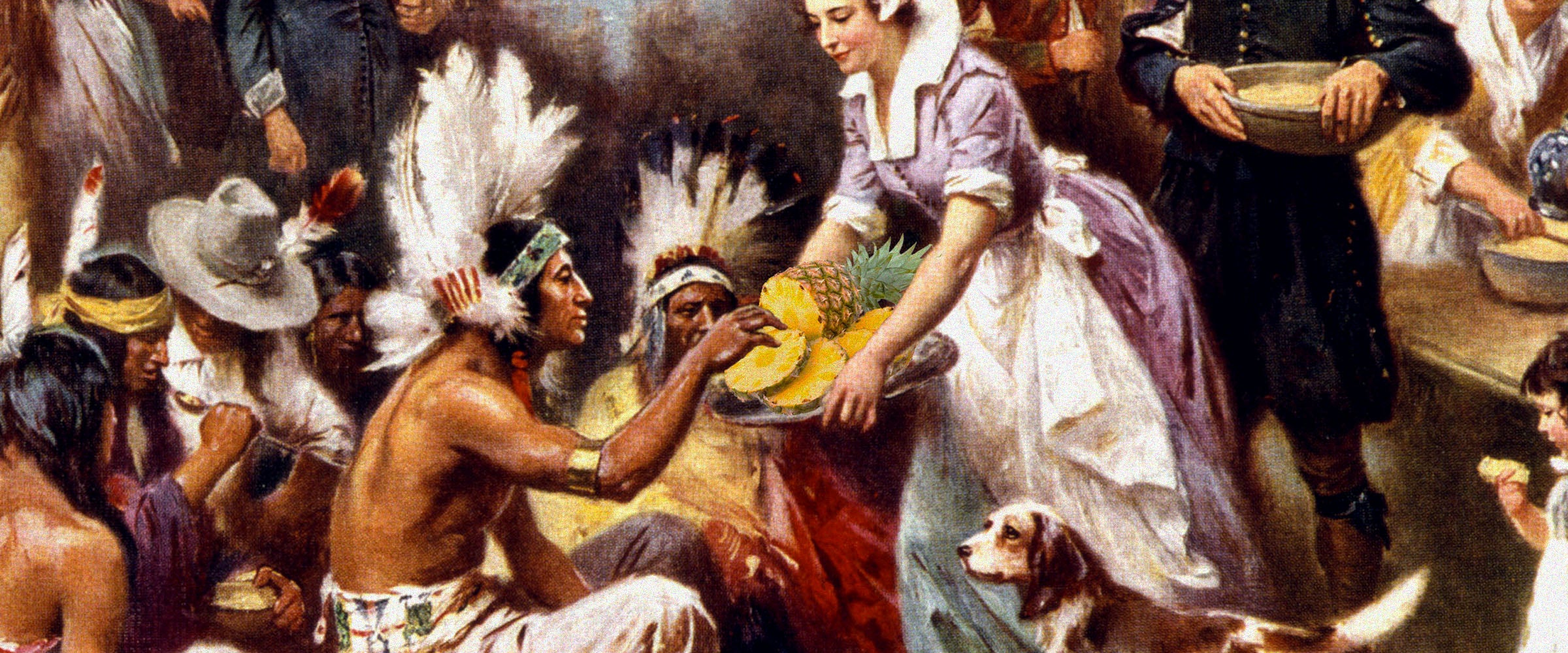Pineapples are suddenly everywhere, and I love it.
One quick Google search for “pineapple accessories” yields pineapple sunglasses, pineapple wine stoppers, pineapple bookends, a pineapple eyelash curler (which sounds scary), pineapple nipple pasties (I totally have a pair), pineapple cooking mats (whatever those are), pineapple-printed sheets to sleep in, and a puffy, pineapple-shaped shaped house for my cat.
Why did the pineapple symbol get so popular? Like many great things, the trend started in the hospitality industry, which has had a real passion for the fruit for about 500 years. In fact, the pineapple is so symbolic of everything we cherish on Thanksgiving — family, friends, feasts and warm, genuine service — that I have a humble suggestion:
Eat it on Thursday. Chase it with rum.
Hear me out. This is how and why that weird, spiky fruit came to symbolize the the ethos of an industry — and why we should all embrace it.
A Royal Privilege
The first recorded interaction between Europe and the pineapple took place in November 1493. Christopher Columbus, on his second voyage to the Caribbean islands, sailed through the entire region, hitting all of the Lesser Antilles before January. He most likely first encountered pineapples on Dominica, his first stop.
According to the the bits and pieces of the surviving logs of that second voyage, Columbus and his men came across pineapples in an abandoned Carib village and were immediately enchanted by a sweet, golden fruit hidden behind a pine-cone-like exterior.
When Columbus headed back to Spain, pineapples and other souvenirs from his journey in tow, the royal classes and European public followed suit and quickly fell in love with the uniquely shaped, exotic-tasting fruit.
The thing with fresh produce and 15th-century trans-Atlantic voyages, however, is that getting from the Caribbean to Spain took several weeks at best, and there was no such thing as refrigeration. An intact, fresh pineapple was, therefore, not only an exciting new delicacy — it was a really expensive luxury. The fruit became a symbol of wealth and privilege, mandatory at all royal gatherings.
If your host brought out a pineapple during dinner, or adorned the table with one, you knew they had spared no expense on the night’s festivities.
Rum-Running in the Colonies
The same was true two centuries later, back across the pond.
“Think about New England back in the 1700s: It was cold, miserable, infested with mosquitoes, everything we despise now with zero shelter or health care,” says Maggie Campbell, president of Privateer Rum in Ipswich, Massachusetts.
“And then someone brings in this well-stored, delicious, juicy, golden delight.”
Pineapples were a status symbol in the colonies, and having one to display was a requirement among the well-to-do (or those who wanted to appear well-to-do) — so confectioners’ shops would actually rent them out for people’s dinner parties.
But, more importantly, a pineapple displayed outside of a home in colonial New England signaled that the man of the house had safely returned from sea: Ship captains would hang a pineapple, collected during their voyage to the Caribbean, outside their home to announce their return and to tell the neighbors he had treats from the islands — namely, rum — to share.
In other words, a pineapple outside a home in colonial New England meant one very specific thing: Daddy’s home. Let’s drink.
Why do many old houses along the New England coast display pineapple iconography? from AskHistorians
Drunk History
Regardless of how America views drinking today, we can’t ignore a very important part of our national history (you know, in addition to imperialism, owning slaves and the eradication of native populations): The Founding Fathers drank like fish in wigs.
Now, this wasn’t all for fun and intoxication. Without running water, indoor plumbing or sewer systems, drinking water in early America was dangerous. Low-ABV beer was drunk more often than H2O, and when water was consumed it was usually spiked with brandy to kill any bacteria lurking in the glass.
But that doesn’t mean the colonists didn’t like their booze. Alcohol flowed so freely throughout the colonies that Harvard University had its own brewery. In 1639, when the school’s president Nathaniel Eaton failed to provide enough beer to the student body, he lost his job.
So yes, people liked beer (and cider, too). But it was rum that truly kept the colonies alive — in more ways than one.
“New England cider manufacture may have been an early casualty of globalization,” Ian Williams, historian and writer, writes in Rum: A Social and Sociable History of the Real Spirit of 1776.
“Apples,” he continues, “could not compete in portability with molasses, and potent though it can be and doubtless was, cider could not compete in strength with rum.”
And so it was. Molasses was by and large an undesired byproduct of sugar refining, but the black goo turned out to be high in minerals and vitamins. And — as was quickly discovered by colonial sailors making trips to the Caribbean for sugar, spices and slaves — it could be distilled.
Caribbean rum will always be distinct from New England rum, of which there is still quite a bit. In the colonial days, New England rum was far inferior to the stuff distilled on the islands. When ships returned north, they were sure to be carrying a literal boatload of molasses to distill, but they were also running cases of Caribbean rum home to drink with friends and family.
So signified the pineapple.
Pineapples in Bars Today
Today, pineapples are common in drinking establishments. In 2010, Absolut vodka launched Absolut Elyx, their luxury vodka, and with it a line of copper, pineapple-shaped drinking vessels. Piña Barware is a newly launched line of bar tools and accessories directly channelling the industry’s passion for the pineapple. W&P has a whole host of pineapple tumblers inspired by the 1950s tiki craze.
Pineapples are on the bottom of mixing tins. They’ve inspired tiki mugs and glassware. They grace many a bicep and forearm of folks behind the bar, showing front and center what the bar — and the person serving your drink — stands for.
Bar culture has changed a lot in the last 20 years, and one of the biggest shifts across the board (other than everyone behind the stick knowing how to make a good cocktail) is the rededication to true hospitality. At face value, that’s simple: it’s being a good host.
But it’s also so much more.
True hospitality is the act of welcoming someone into your home and not just treating them with respect, but taking pleasure in making them comfortable. It’s the extra slices of baguette arriving for your cheeseboard without you asking. It’s always having a full glass of water in front of you. It’s an unordered taste of a cordial your bartender overheard you and your date discussing. It’s stopping to offer directions to the couple staring hopelessly at a map of the subway.
The Japanese have a word for this ethos: omotenashi. And while the Western world at large still pales in comparison to the genuine culture of hospitality in Japan, Americans with careers in bars and restaurants (and hotels) today hold the spirit of omotenashi close to our hearts.
And so, we have the pineapple.
In short, the pineapple symbolizes welcoming people into your home, the desire to turn strangers into friends — and, yes, freedom to pour the booze heartily.
So if you’re headed to dine with friends and family for Thanksgiving and need a last-minute seasonal tribute to the table, bring a pineapple. It’s a great conversation piece.
I guarantee it’ll distract from Cousin Jimmy’s MAGA hat.

